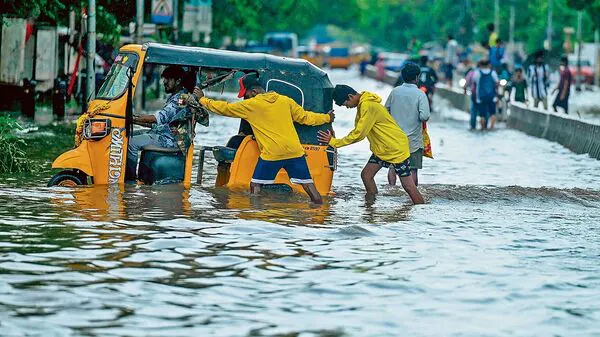Chennai, the capital city of Tamil Nadu, witnessed intense rainfall on Thursday, bringing much-needed relief from the humid heat but also raising fresh concerns of waterlogging, traffic snarls, and flood preparedness. The India Meteorological Department (IMD) has issued a new warning for the city and surrounding coastal districts, predicting more heavy showers over the coming days. With monsoon systems becoming increasingly unpredictable, the city is once again bracing for challenging weather.
This blog takes a detailed look at the latest rain event in Chennai, its impact on the city, IMD’s forecast, government measures, and what residents should expect going forward.
The Rain Event: A Sudden Downpour
The day began on a normal note for Chennaiites, with cloudy skies and humid conditions. By afternoon, however, the city was lashed by heavy showers in several parts, including T Nagar, Anna Nagar, Velachery, Guindy, Tambaram, and Adyar. The intensity of the downpour caught many off guard, leading to flash waterlogging on arterial roads and low-lying residential areas.
According to initial estimates, some parts of the city received rainfall ranging from 30 mm to 70 mm within just a few hours, causing traffic congestion and delays. For a city that often struggles with drainage during intense showers, this spell served as a reminder of the fragile urban infrastructure.
IMD Forecast: What Lies Ahead
The India Meteorological Department, which has been closely monitoring the evolving weather system over the Bay of Bengal, issued a yellow warning for Chennai and its suburbs. The forecast highlights:
- Heavy to very heavy rainfall expected in isolated areas of Chennai, Chengalpattu, Kanchipuram, and Tiruvallur districts.
- Strong winds reaching up to 40–50 km/h may accompany rainfall along the coast.
- Fishermen have been advised not to venture into the sea due to rough conditions.
- The possibility of thunderstorms and lightning during evening hours in urban clusters.
Meteorologists attribute the rains to the interaction of a low-pressure system over the Bay of Bengal with the monsoon trough, which has shifted closer to the Tamil Nadu coast. While such systems bring beneficial rains to replenish reservoirs, they also heighten the risk of urban flooding in a densely populated city like Chennai.
Impact on Daily Life in Chennai
1. Traffic Disruptions
Several busy roads including Mount Road, OMR (Old Mahabalipuram Road), and Inner Ring Road witnessed traffic snarls as vehicles struggled through waterlogged stretches. Office-goers faced long delays, while two-wheeler riders were among the worst affected.
2. Public Transport
Suburban train services continued largely unaffected, but Metropolitan Transport Corporation (MTC) buses were delayed due to inundated routes. Metro Rail, on the other hand, saw an increase in ridership as commuters opted for safer alternatives.
3. Residential Areas
In localities such as Madipakkam, Pallikaranai, and parts of North Chennai, residents reported waterlogging inside homes. This has revived concerns about the city’s stormwater drain capacity and the pace of ongoing infrastructure upgrades.
4. Power Cuts and Services
As a safety measure, power supply was temporarily suspended in certain flood-prone pockets. Telecom services, however, remained mostly unaffected, unlike previous years when connectivity used to suffer during rains.
Government Measures and Preparedness
Learning lessons from the devastating 2015 Chennai floods, the Tamil Nadu government has been actively working on improving flood preparedness. Following the latest downpour, the Greater Chennai Corporation (GCC) deployed pumping machines in vulnerable areas to clear waterlogging.
Key measures include:
- 24/7 helpline numbers activated for reporting waterlogging and emergencies.
- Quick Response Teams deployed with motor pumps in zones like Velachery and Perambur.
- Desilting of stormwater drains carried out in many areas ahead of the monsoon season.
- Coordination with traffic police to regulate vehicular movement in waterlogged stretches.
Despite these efforts, urban experts note that rapid urbanization, encroachments on waterways, and poor waste management continue to undermine Chennai’s resilience against heavy rainfall.
A Look Back: Chennai’s Tryst with Rains
Chennai’s relationship with the monsoon has always been a double-edged sword. On one hand, rains are crucial to recharge reservoirs such as Poondi, Chembarambakkam, Red Hills, and Cholavaram, which serve as lifelines for the city’s drinking water. On the other, intense spells often trigger flash floods.
Major Events in Recent History:
- 2015: The infamous floods that crippled the city for weeks, claiming hundreds of lives.
- 2017: Cyclone Vardah brought widespread destruction with heavy rains and winds.
- 2021 & 2023: Repeated instances of localized flooding despite new stormwater infrastructure.
The present rainfall, though not catastrophic, once again highlights the urgent need for long-term urban planning.
Environmental and Climate Angle
Experts point out that climate change is altering monsoon patterns, making rainfall more erratic and intense. Chennai’s coastal location makes it especially vulnerable to:
- Cyclonic storms from the Bay of Bengal.
- Sea-level rise, which threatens drainage efficiency.
- Urban heat island effect, amplifying storm activity.
Environmentalists stress the importance of restoring water bodies, wetlands, and open spaces that naturally absorb rainwater. Once thriving lakes like Velachery and Pallikaranai marshlands have shrunk due to encroachments, reducing the city’s natural flood buffers.
Voices from the City
Chennai residents took to social media to share pictures and videos of the rain, from flooded streets to children enjoying the downpour. While many welcomed the relief from scorching heat, others expressed frustration at water stagnation.
One office-goer tweeted, “Every year, same story. A few hours of rain and the roads become rivers. When will Chennai really be flood-proof?”
In contrast, another post read, “Chennai rains bring nostalgia, tea, and bajjis. Despite the waterlogging, the cool breeze makes up for it.”
These contrasting voices reflect the love-hate relationship Chennaiites share with the monsoon.
What Residents Should Do During Heavy Rains
With the IMD warning in place, experts advise residents to remain alert and take precautions:
- Avoid unnecessary travel during peak downpours.
- Keep emergency numbers handy, including GCC helplines.
- Ensure electronic devices and valuables are safe from waterlogging.
- Stock essential groceries and medicines to avoid stepping out during severe rain.
- Watch out for open manholes and damaged electrical lines in flooded areas.
The Road Ahead: Can Chennai Adapt?
Chennai’s recurring struggles with rainfall highlight a pressing urban question—can the city adapt to a changing climate while ensuring sustainable growth?
Urban planners advocate for:
- Reviving traditional water bodies to serve as natural flood sinks.
- Strengthening stormwater infrastructure with modern technology.
- Sustainable urban planning, avoiding construction on marshlands and floodplains.
- Public awareness campaigns to reduce plastic waste that clogs drains.
Only a combination of strong governance, scientific planning, and citizen cooperation can help Chennai overcome its annual battle with the rains.
Conclusion
The latest spell of heavy rain in Chennai is a reminder of both the blessings and challenges that the monsoon brings. While it replenishes reservoirs and cools down the city, the accompanying risks of waterlogging and flooding remain ever-present. The IMD’s warning for more showers ahead means Chennaiites must stay alert and prepared.
As the city continues its journey toward modernization, it must not forget the lessons from its watery past. With smarter planning, ecological restoration, and citizen participation, Chennai can transform its monsoon woes into an opportunity for sustainable urban living.
FAQs
1. Why did Chennai receive heavy rainfall suddenly?
The rains were triggered by a low-pressure system over the Bay of Bengal interacting with the monsoon trough, causing localized heavy showers.
2. What warning has IMD issued?
IMD has issued a yellow alert, forecasting heavy to very heavy rainfall in Chennai and surrounding coastal districts.
3. Which areas of Chennai were most affected?
T Nagar, Velachery, Anna Nagar, Tambaram, and Guindy reported significant waterlogging.
4. Is there a risk of flooding like 2015?
At present, rainfall levels are not comparable to 2015. However, continuous heavy rains may still cause flooding in vulnerable areas.
5. How should residents prepare?
Residents should avoid unnecessary travel, stock essentials, protect valuables from water damage, and report waterlogging to GCC helplines.

